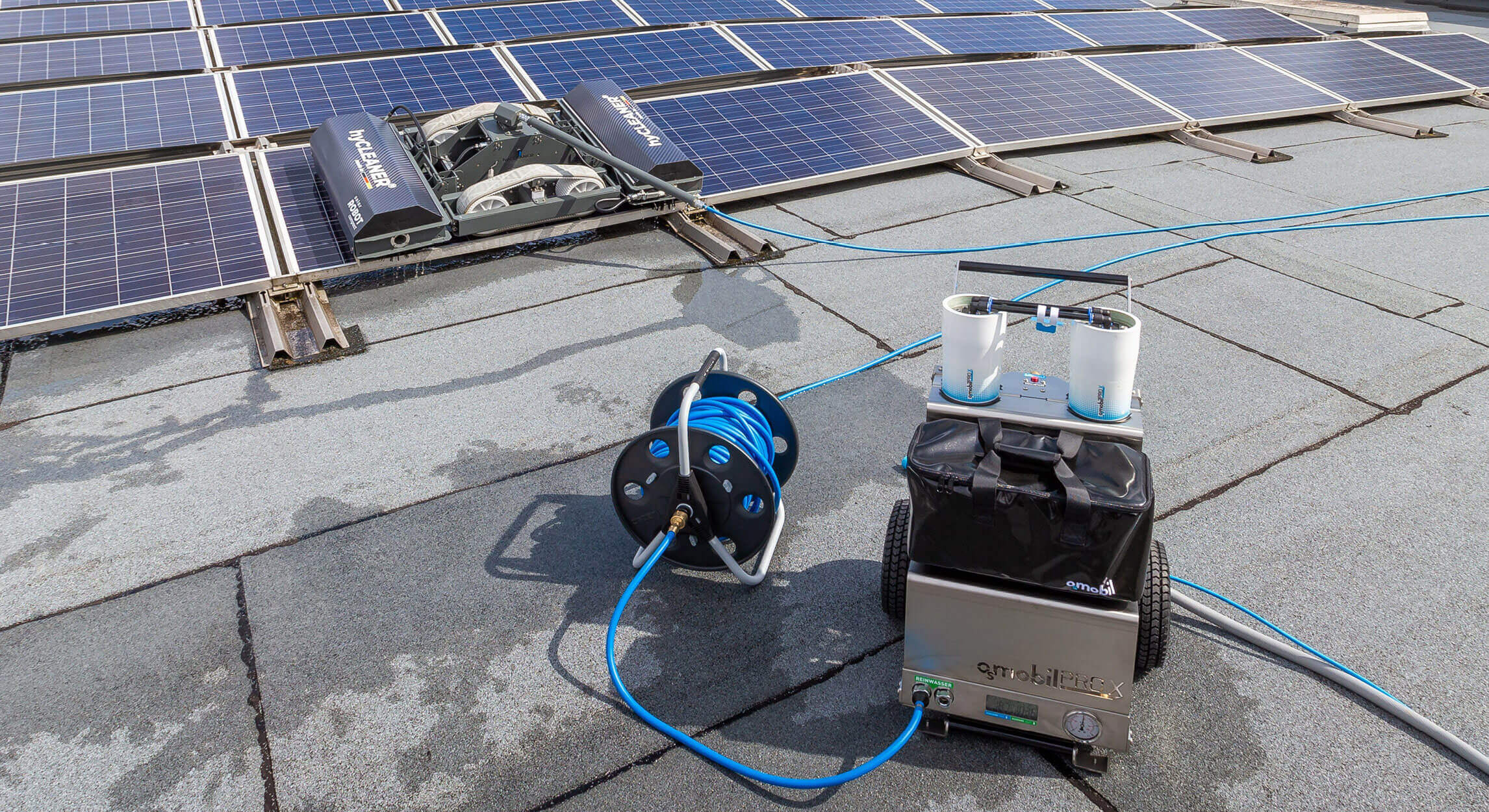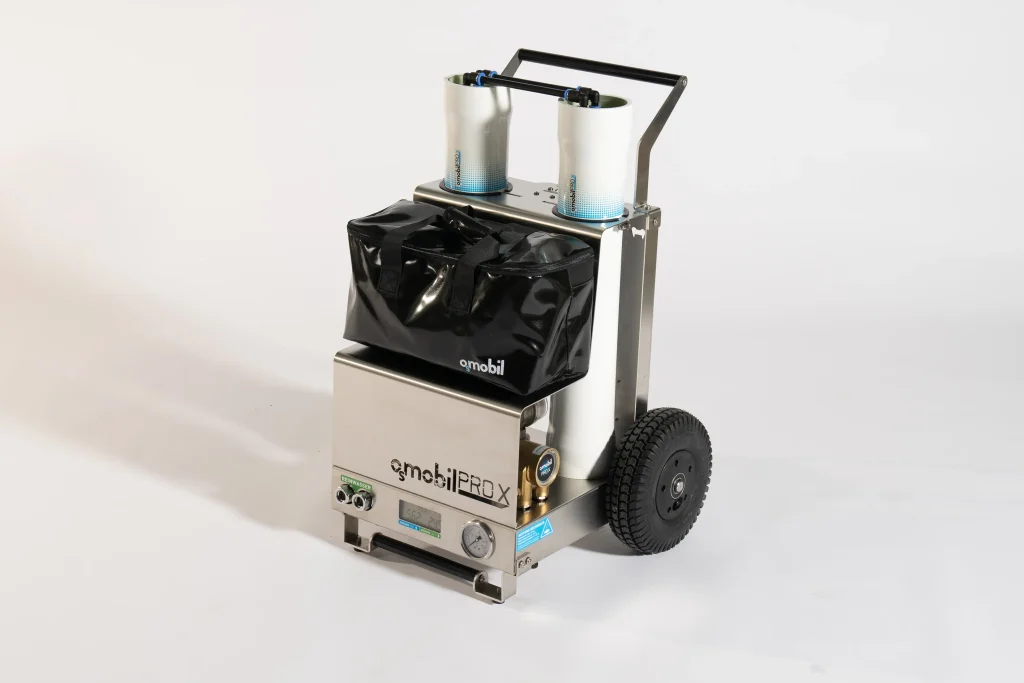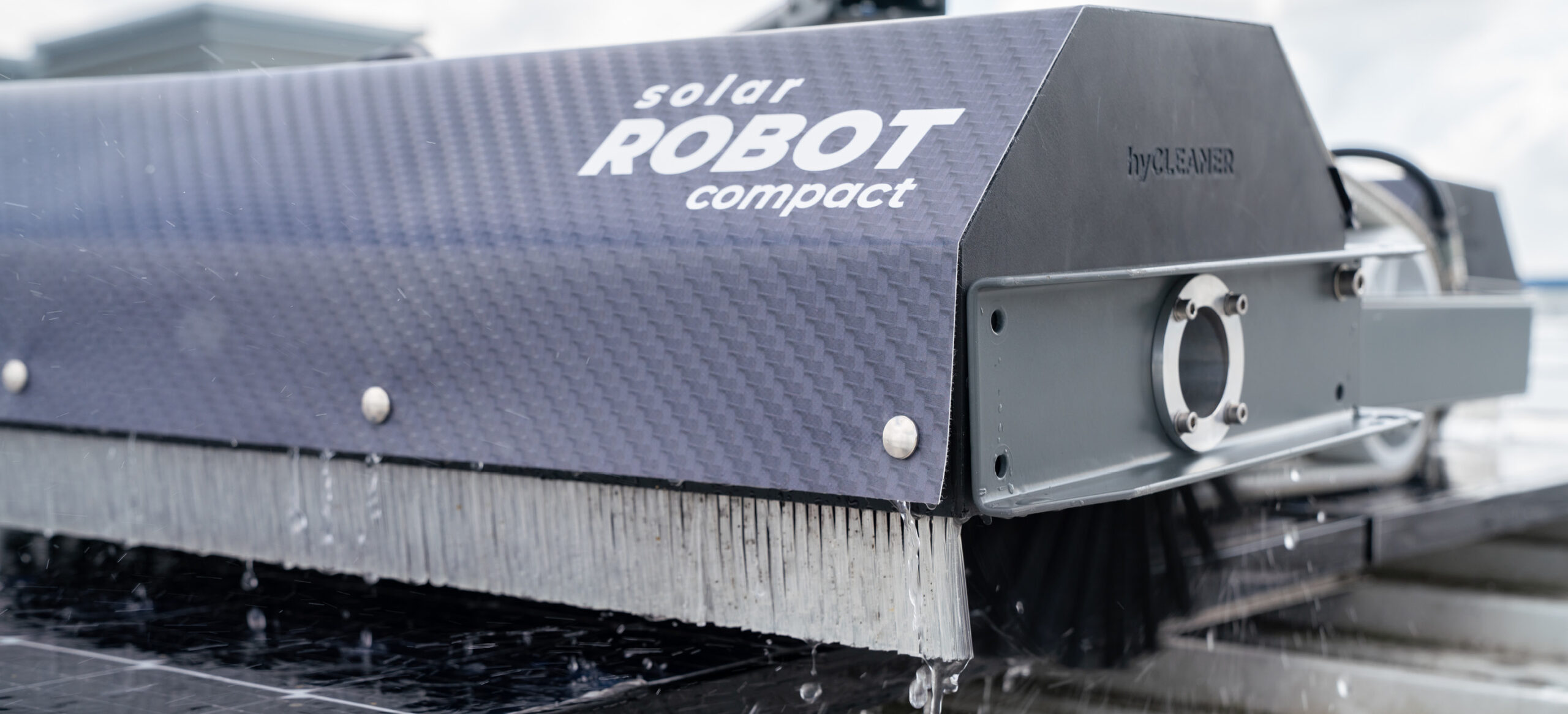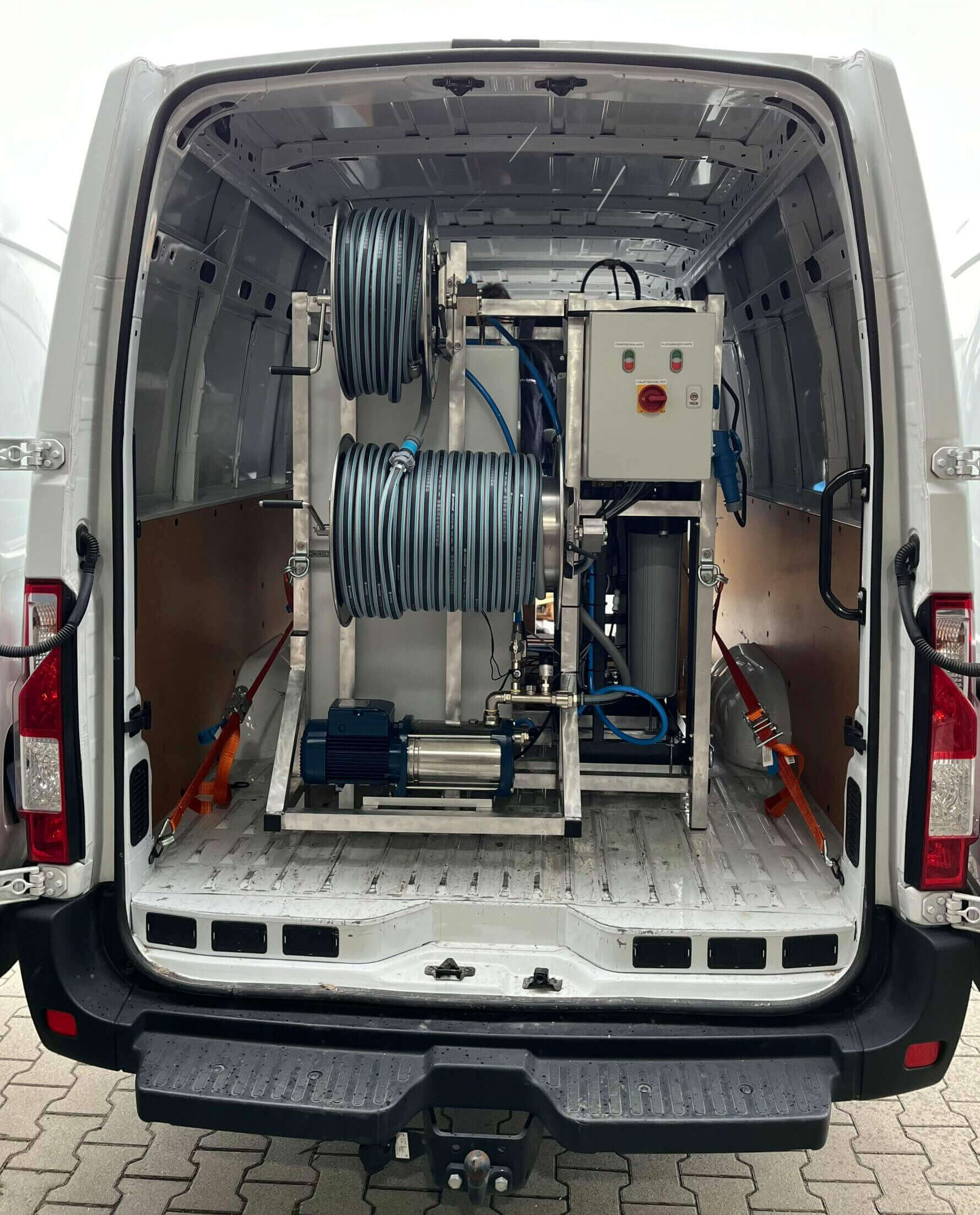The environment, the health of the cleaners and the cost of cleaning agents – the disadvantages of cleaning with chemical agents are manifold. But there is already a good alternative. This is because osmosis deep clean works exclusively with treated water thanks to a special filter technology. In combination with an effective mechanical brush, the treated water enables environmentally friendly and efficient cleaning. How exactly does reverse osmosis cleaning work and how do companies best use the method to clean PV panel modules, large glass surfaces such as glass roofs and facades?

Reverse osmosis cleaning uses treated tap water. This usually contains various minerals, lime and salts. If the normal tap water evaporates, these components remain on the surface, for example in the form of limescale stains. Even if these are only very fine residues, they form a slight bump to which soot particles and dust, for example, get caught. As a result, the cleaned surface gets dirty more quickly and has to be cleaned again after a short time.
During reverse osmosis cleaning, the water first passes through a special reverse osmosis filter system, which cleans the water of these smallest components. As a result, there is no residue during evaporation and the surface stays clean for longer. At the same time, the cleaning power is so good that aggressive cleaning agents with silicones, synthetic abrasives or acids become superfluous.
Substances such as water molecules as well as minerals and salts generally try to distribute themselves evenly. In osmosis, two water chambers are separated from each other by a semi-permeable, i.e. semi-permeable membrane. If the concentration of molecules on the two sides differs, the matching molecules flow through this membrane. This so-called osmotic pressure persists until the concentration is balanced on both sides.
In the case of cleaning with so-called pure water (also known as osmosis water, technical water or ultrapure water), reverse osmosis is used to counteract this osmotic pressure. The goal: on the one hand, to produce water that contains as few minerals and salts as possible, while on the other hand, these substances are washed away. In order to overcome the osmotic pressure, reverse osmosis involves forcing water through this membrane at a temperature of at least 3 bar. The smaller water molecules can pass through them, while the substances undesirable for cleaning are retained by them. The higher the tap water pressure, the purer the osmosis water will be at the end.
Did you know? Instead of flushing the wastewater down the drain, the minerals it contains make it ideal as fertilizing water for plants.
During reverse osmosis cleaning, normal tap water is treated. The water quality is measured in ppm and influences the settings at the plant. In Germany, the water hardness is between 70 ppm (very soft water) and about 500 ppm (very hard water). For reverse osmosis cleaning, a value of less than 30 ppm is required for facades and solar, and a value below 15 ppm for glass.
Depending on the country, the water quality differs, so there are no universal settings for the osmosis machine to achieve these values. However, in order for the filter system to work as intended, it is necessary to use normal tap water. Well water or water from similar sources is often too polluted and quickly clogs the filter.

In addition to reverse osmosis, mixed-bed resin filters offer the possibility of producing pure water. Although these are initially cheaper to purchase, the follow-up costs are all the more expensive. While costs of €15 to €100 per 1,000 litres are incurred for mixed-bed resin filters, depending on the water hardness, the costs for cleaning with a reverse osmosis system are consistently below one euro. The cost of using a mixed-bed resin filter is therefore up to 100 times more expensive to use.
Due to the cost and practical application, a system with a mixed-bed resin filter is only suitable for small, sporadic applications for plants of up to 100 kWp with soft water, while an osmosis system works effectively and efficiently even for large orders.
With reverse osmosis cleaning with pure water, companies benefit from advantages in terms of the safety of the cleaners and the cleaning costs, but this process is also much more sustainable for the environment.
Many surfaces are not designed for a high point load capacity. Large glass surfaces and many roofs, for example, are often not allowed to be entered for cleaning of the glass surfaces themselves or of PV panel systems for reasons of occupational safety. In such cases, a cleaning robot that is placed on the roof from a working platform and remotely controlled is suitable. This is designed for the load capacity of roofs and the like, so that cleaning can be carried out safely. A robot can also reach angled surfaces, which are becoming more common due to advances in modern architecture and the development of construction methods.
A robot also saves the company financial resources. With the help of the perfectly matched brush and the right amount of water, it not only cleans effectively, but also more efficiently compared to manual cleaning.
At the same time , the osmosis effect increases the cleaning power. The pure water absorbs particles better because they want to be distributed by the osmotic pressure. There are hardly any foreign particles in the water, which is why the osmotic pressure is particularly strong here compared to the dirty surface.

This also has a positive effect on the environment. Thanks to the efficient cleaning with only water, no chemicals get into nature and into the wastewater, which would otherwise have to be treated at great expense. At the same time, the intervals until the next cleaning are extended, as dirt no longer adheres to the limescale edges. This also saves resources and protects the environment.
In combination with mechanical cleaning, this not only enables effective and efficient cleaning, but also sustainable and chemical-free cleaning. With a hand brush, it is not possible to generate enough pressure and speed in the brush rotation to remove even stubborn dirt. The cleaning robot, on the other hand, ensures an optimal cleaning result thanks to its high brush rotation and the corresponding amount of water. In combination with osmosis water, surfaces are also freed from dirt that is difficult to dissolve, while the water dries without leaving any residue and thus slows down resoiling.
In principle, ultrapure water can be used to clean all smooth and closed surfaces, whichcan be found on glass façades, metal façades and solar and PV panels. The following three examples show what reverse osmosis cleaning with a cleaning robot looks like in practice and how companies benefit from it.
Glass surfaces such as glass roofs or window surfaces in large industrial halls are generally very susceptible to dirt and require a lot of maintenance, as soiling caused by the weather, exhaust fumes, weathering, plant growth, bird droppings and so on are quickly visible. At the same time, cleaning is important to prevent fatigue of the material.
However, cleaning involves a high risk of accidents due to the height, an increased risk of slipping in dirt and moisture, and modern architecture that makes access difficult. In the case of multi-storey and spacious buildings, special building shapes or sloping glass surfaces, reverse osmosis cleaning with a telescopic rod is no longer possible. This is because many roofs are not allowed to be entered, as this can lead to serious accidents at work.
A robot, on the other hand, is adapted to the load capacity and structure of the buildings. The workers stand in the safe basket of a work platform from which they control the robot. A hose supplies the robot with ultrapure water or tap water. Due to the cleaning properties of the pure water and the efficiency of machine cleaning, the intervals before the glass needs to be cleaned again are extended. Reverse osmosis cleaning by a robot therefore improves occupational safety and reduces the costs for materials and frequency of cleaning.
Photovoltaic systems are most efficient when they are clean, according to the Institute for Solar Research of the German Aerospace Center. But they also pollute with dust, sand, pollen, ammonia, leaves or bird droppings. As a result, they need to be cleaned regularly to prevent large yield losses. Cleaning with osmosis water and a robot is particularly suitable for photovoltaic systems, as the individual solar cells are very sensitive. Strong cleaning agents with acids or abrasives, hard brushes or high-pressure cleaners can quickly cause damage here.
At the same time, conventional cleaning methods for large areas are very time-consuming, physically demanding and uneconomical. Floating or roof-mounted systems also pose a high safety risk for cleaning staff. A robot is therefore a good way of tackling these challenges.
Facades are mainly polluted by verdigris, lichens, moss or industrial pollutants. Regular cleaning improves the external appearance and improves the longevity and value retention of the building. Depending on the material, many chemical cleaning agents are too aggressive and can damage the façade. The osmosis process cleans efficiently without chemical agents.
In combination with a façade brush, which is attached to a work platform and controlled by it, large areas can be cleaned gently and efficiently at the same time. It is therefore also suitable for large shopping centers, furniture stores such as Ikea and other large buildings. All-in-one systems combine the use of osmosis water and cleaning robots as a professional cleaning system.

The use of technical water, in combination with robot-assisted cleaning, is suitable for cleaning surfaces efficiently, effectively and sustainably. This is because the two technologies combine a wide range of advantages: Thanks to the high mechanical brush performance and the use of osmosis water, chemicals can be completely dispensed with. The robot also enables companies to achieve the highest safety standards, as employees can control it safely from the basket of a work platform.
Would you like to learn more about the possibilities of a cleaning robot or reverse osmosis cleaning? Then contact us!
You are currently viewing a placeholder content from Facebook. To access the actual content, click the button below. Please note that doing so will share data with third-party providers.
More InformationYou are currently viewing a placeholder content from Instagram. To access the actual content, click the button below. Please note that doing so will share data with third-party providers.
More Information